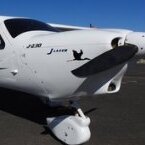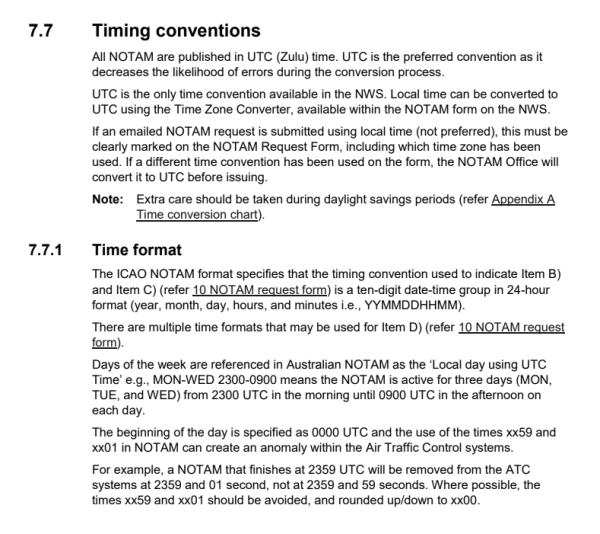-
Posts
3,464 -
Joined
-
Last visited
-
Days Won
47
Content Type
Profiles
Forums
Gallery
Downloads
Blogs
Events
Store
Aircraft
Resources
Tutorials
Articles
Classifieds
Movies
Books
Community Map
Quizzes
Videos Directory
Everything posted by RFguy
-
NO No NO !!! the question here is not about how to convert UTC to local but that the NOTAM was issued in LOCAL time not UTC !!! https://www.airservicesaustralia.com/wp-content/uploads/NOTAM-Data-Quality-Requirements-for-Airservices.pdf Here is where people lodge this stuff, let's take a look at it - NOTAMS are supposed to be lodged by an Authorised Person. https://www.airservicesaustralia.com/industry-info/flight-briefing/notam-originator/ It is well explained !!! 2.1.4, 2.1.5 in NWS-User-Guide.pdf clearly spells that out 5.2 NOTAM Authorised Persons verification of https://www.airservicesaustralia.com/wp-content/uploads/NOTAM-Data-Quality-Requirements-for-Airservices.pdf so, WTF ???!! If it was UTC, and they were running behind on their overnight work, then they should have realised this 2 hours before and issued a new NOTAM. CAN YOU TELL i HAVE A SORE BACK RIGHT NOW ?
-

Light plane crash Hillcrest QLD 6.4.23
RFguy replied to trailer's topic in Aircraft Incidents and Accidents
My J230 fuel drains leaked... (changed O rings- and dont forget the header tank drain O ring) . Not fast enough to make a difference but eventually they would have. @Thruster88- what's the service requirement on a GA plane like a Cherokee for fuell drain components- inspection or mandatory time limit ???? -

3rd April 2023 Proserpine light aircraft crash.
RFguy replied to trailer's topic in Aircraft Incidents and Accidents
Many reasons above why I am studying for my Instrument Rating.... Seems to me to be the obvious next step in my training. I do accept there is a fairly steep cost associated with acheiving it, and this may be unreachable for some, and some would prefer to spend their $ elsewhere, or dont have those specific aviation interests- IE horse for courses. For me- well the science/engineer side of me loves proceedure and challenges... -
For an RAAUS to RPL conversion - If the instructor is satisfied for a checkride- then that's all there is to do. might take 30 min, might take 5 hours. depends how proficient you are with the heavier , different airplane. CTA, etc they are endorsements. just like NAV. I have my RAAus NAV so that endorsement got added to the RPL. You dont need the CTA endorsement etc for the RPL (but you cant fly in CTA without it). Really- RAAUS PC and basic RPL is nothing more than a tighter medical requirement , english language proficiency (ELP) evaluation, and a checkride. Oh and there are some minimum hours requirements stipulated in all the CASA forms.
-
and note well- there is a strict limit to the pressure drop permitted in the system, (on the suction side)- pretty well dictated by the oil cooler. You'll find oil coolers that are wide in width and short in height (IE long tubes left to right ) will not meet the rotax vaccuum limit requirements. Tall, with lots of short tubes will usually meet the vaccuum limit requirement. SETRAB publish the pressure drop for oil flow at some oil visc spec.
-
mmm Probably best way to find it would be a low VHF + high UHF downward looking radar looked for energy rerradiated from long lengths of metal. You'd find alot of fencing wire along the way.... So team it with a hi resolution, near infrared camera to look through the jungle and team it up with some software to figure out what is airplane wreckage and what is fencing wire. Radar could change frequency to discern fencing wire from aircraft parts. Use RH+LH circular polarized antenna at UHF and you'd discern sheet metal from fencing wire and thin shapes ..... It's possible. I'll find it if someone wants to. - glen
-
OK 10 rows, 8.3mm spacing per row, likely double core (~ 45-50mm thick etc) , and 187.5 cm2. pretty small ! pressure across it must be good. Bob - sure that wasnt the Oil cooler ????? FWIW - The rotax install manual specifies "Experience has shown that with good airflow, a radiator with an area of 500 cm² (77.5 in²) is required for troublefree op- eration.". .. Now, I think that is going overboard unless you are flying at 50 kts..... I think it needs to be about 300 to 400 cm2 minimum. depends on airspeed.... The rotax pulls out alot more heat into the heads from the heavy aluminium cylinders , compared to the Jabiru LCH which the low conductivity steel - the heat is localized.
-
thanks. see how much time we have. MDX - I did some reading. wow, quite a story. Likely in 10,000 pieces down a gorge in the Barrington Tops region. OR, got into an updraft, high, high, then carried out to sea and uncerimoniously dumped in pieces in the South Pacific Ocean ? Or taken by Aliens , and assimilated, IE advanced Cessna strutless technology integrated into their spacecraft collective ?
-
Mike, Thruster and I will be flying DRF back to Cowra over a couple of days of queensland sightseeing late April, from YCHT, maybe a 130ish track to the coast , then done the coast for a while. Any suggestions since this is your neck of the woods ?
-
yeah, so the Sav dimensions are likely suitable. If you have a fast airframe, (more available air pressure) you can save a little frontal area with a triple core radiator. (thicker, higher air pressure drop across it , but more work done per square inch of frontal area) . Most of the motobike radiators, like the Kawasaki Ninja radiator I use for 3300 LCH conversions, $110, have 19mm hoses. Of course you need 25mm hoses for the 'tax, there are many ebay chinese suppliers of rotax compatible radiators. they're probably all fine. $200-$250. Buy a spare if concerned. Carrying a spare is both cheap and light solution to oan otherwise big problem if it fails / gets stoned (the aircraft, not the pilot) .
-
What is the frontal area available, and what will be the climb airspeed , and cruise airspeed ?
-

Light plane crash The Oaks, 30 March 2023 (edited)
RFguy replied to red750's topic in Aircraft Incidents and Accidents
Thanks OneTrack et. al for the info. Oh combustable and flammable are different things?. Well there ya go I learned something. OK doing my research, there are quite alot of limits imposed. fair enough. The Jab takes 140 litres . The Archer is 182 ish. The Archer has a MOGAS STC which I might take advantage of , at least in winter. Might ask users and see if anyone has had issues of any sort that can be put down to fuel. But it wont be local pump gas, IE will be drum or better. Or some means of verifying the integrity of the pump ULP before it goes in the certified aircraft, per the STC guidelines/ Lycoming. Not a money saver, just trying to keep the lead deposits out of the engine if I can. Although, before too long, might we have AVGAS-ULP ? AS1940 has a bit to say, now need spill response kit for all storage......and then there are state rules...golly. talk about varied ! .... locally : Interesting, on rural properties, the bunds around it to hold spills etc must have the capacity of 20 minutes of fire fighting water. At home , between 100 and 250 litres depending on where you are, and danger signs may be required to be displayed. Hard to find much info at the 'single drum storage' size. Might talk to fuel trailer providers and see what they say. and the Sydney Recreational flying club at The Oaks. The club has expressed interest in a ULP fuel trailer at Cowra- sharing in the running / use of that that would most likely be the best overall economy of scale. -

Light plane crash The Oaks, 30 March 2023 (edited)
RFguy replied to red750's topic in Aircraft Incidents and Accidents
I want to investigate buying drum or drums of ULP98. Anyone here much experience with buying drums? I bet there are. IE not necessarily premium unleaded with all the fancy additives, just ULP98, which is listed in a few of the available products. Is a single drum on a trailer and approved screw into drum pump/ filter reasonable or is it better to have a bigger - say 600-100 ltrs fuel trailer and fill that up from a truck ? I dont really want to encounter / infringe on needing large volume storage permits etc. And a drum a week would be plenty. -glen -

Light plane crash The Oaks, 30 March 2023 (edited)
RFguy replied to red750's topic in Aircraft Incidents and Accidents
Yeah, my comments relate to Gen 1,2,3. In my opinion - systematic issues of Gen1,2,3 are pretty well covered off and mitigated in Gen4 (head integration). and other non head stuff like flywheel bolts / attachment - sorted, propeller flange extra dowels, - sorted. Pistons seem to still go bang, but they are few in numbers. Lycoming have lightweight pistons that fail, also. Not alone.... With exception - that , IMO, the TBO on AVGAS ( without additive that reduces lead products buildup ) is about 300 hours (Gen1,2,3,4), and that fresh ULP98 is best fuel for Jabirus by far. Running 95/98ULP in Jabirus that have had lots of avgas and have lots of buildup I would avoid because of potential glow/preiginition issues due to buildup. -

Light plane crash The Oaks, 30 March 2023 (edited)
RFguy replied to red750's topic in Aircraft Incidents and Accidents
As I have mentioned before.. There are a few things , IMO, that Jabiru Engines SHOULD HAVE been alot more proactive of fixing / SB issue. Someone in the company, IMO, made a judgement call (which i disagree with) that IMO, they considered the reputational loss was acceptable and allowed parts and systems to fail in airborne aircraft. (or were not sufficiently competent and didnt understand the rather basic problems) . However I think an equal number of Jabiru engine failures are due to, let's call it... "Variable maintenance practices". There is half of me that's had about enough of the Jabiru company mindset, and makes me want to sell my J230..... but the other half of me knows that the J230 airframe is one of the best flying options around. Economy, speed, performance.,- that wing is gorgeous to fly with compared to GA trucks. Putting aside I have bought an Archer1 and am studying for my Instrument Rating - that is a separate pathway - the J230 and the Archer are two completely different mission providers. -

Microair 760 Radio - High pitch tone
RFguy replied to ozzietriker's topic in Instruments, Radios and Electronics
sounds like the mic is feeding back through the intercom / sidetone facility . turn down the sidetone, or mic gain, or intercom tweaks. is the volume of the squeal track with the volume control on the panel ? -

Oil cooler placement and ducting advice - Rotax 912ULS, CH701
RFguy replied to Marty_d's topic in Engines and Props
check whole oil system checks per rotax manual : HAS A OIL SYSTEM VACCUUM CHECK BEEN DONE PER THE ROTAX INSTALL MANUAL ?? YES / NO ???? (1.4) HAS OIL SYSTEM AIR PURGING BEEN DONE PER ROTAX MANUAL ? (1.5) HAS THE CRANKCASE PRESSURE BEEN CHECKED PER ROTAX MANUAL ? (1.3) ARE LENGTHS AND MIN DIAMETERS AND BENDING RADII BEEN OBSERVED PER ROTAX MANUAL ? What were the values written down in ther maintenance book ? What was the vaccum reading at the T ? Section : INSTALL MANUAL. Lubrication system, 1.1, 1.2, 1.3. 1.4 1.5. If this has not been done either re-educate or sack your mechanic. -
I dont like carbon fibre at all if it is damaged- mostly is not repairable, splintered, fractures along weave lines . Terrible stuff. Fibreglass would be #1 choice, especially with chance of needing repair/damage over the lifespan. As for fashion ? Customers need to be educated on the disadvantages of carbon fibre, and advantages of fibreglass.
-

Oil cooler placement and ducting advice - Rotax 912ULS, CH701
RFguy replied to Marty_d's topic in Engines and Props
a few pictures would be useful for us. Rotax might say 140 is max but reality the mfrs will tell you 110C would be maximum continuous temperature . Engines oils get thinner with higher temps and this also affects the "oil bearing" that can be provided. between bearings and journals. Not to mention cylinders and pistons.... If using a radiator of area of say, 160cm2 is used, (rotax minimum suggestion) in some service note, that's for a min 75 kts aircraft. you might need bigger for slower aircraft. If you have a good size radiator already, that would imply something bad going on (assuming the temperature measurement is sound) , airflow throu the core is not as you expect- is the core blocked possibly ??? Is the hose between the oil pump inlet and the radiator sucking in ? there is high vaccuum there. Is the oil cooler too high pressure drop ? ****IE is the oil flow slow? BECAUSE slow oil flow will yield higher temperatures on exit from the engine. slow flow means high temperature differences. slow flow means cooler exit from the radiator and hotter exit from the engine . Fast flow reduces temperature difference (rise) . -
tell them hovercraft. I've found the Ninja 250 radiator is a good size for a 'tax, has conveniently located pipes - a good one (19mm). you want 25mm for the 'tax I presume. $100 at various local sellers. If you are pressed for frontal area, consider a triple core. You'll have plenty of pressure to drive it.
-
Looking good skip. that would be my approach. you still get some cylinder cooling this way. Who made your radiators- I was looking to do that on the Jabiru but cost of two custom radiators was quite high. what is the cylinder at the bottom ? oil -water heat exchanger ? or cabin heater ? the formula for inches of water pressure can be simplified to (airspeed knots * airspeed knots) / 1600
-
Log into CASA "self service" and you can see the status of your requests... and there is a Service request number that you can use to ask about progress. you can apply for username password for this service easily enough. My RPL conversion application is sitting there waiting to be looked at.. https://customer.casa.gov.au/webclient/index
-
I've never seen any stone damage in the very low mounted Jabiru oil cooler. Do propellors (on GA) 'suck' stones in from in front of them , or do they stir up the stones beneath them ? As I commented elsewhere, its all about whether you can acheive an air pressure differential across the radiator, which is VERY cheaply assessed with a clear bit of tube and some water. if its frontal facing, you can estimate the frontal pressure using the formula for inches of water = ((airspeed knots * airspeed knots ) * 25 ) / 40000 Then have a tube from behind the radiator to static . performance will be compromised by how much air is getting into the cowl (if the radiator exit is in the cowling) If the radiator is ducted, like many GA, have the tube across both sides of the radiator.
-

Oil cooler placement and ducting advice - Rotax 912ULS, CH701
RFguy replied to Marty_d's topic in Engines and Props
Hi Marty. Have you had time to read through the 912 and 914 (has more useful info) rotax installation manuals ? there is lots of meat in them, Now, what i would be looking for is : can you satisfy / provide the required pressure differential across the cooler? That's the $64 question. The thin coolers like std rotax - well there is very much ambient temp and heat input variables, but they can work for typical 912 usage with as little as 2.5" of water , but the deep coolers like #800075 , needs about 5 inches of water for typical loads. Slowish aircraft like the Archer, (100 kias cruise) they have an # 800075 aeroclassics cooler ( a deep cooler that needs lots of differential pressure to work) - it is mounted on some 4" scat from the nose of the plane and tghe cooler, with the duct mounted at the firewall. that cooler is same as factory Jabiru used for 3300. so really, it comes down to if you can make pressure across the cooler. poke a tube with water meas into the shroud at the cooler to find out ... Dont forget you need to duct air over the cylinders (per Rotax) where possible. otherwise a ton of extra heat load goes into the water system usually from the rear cylinder not getting the blast. -

Light aircraft crash - NT - 25/12/2022 - 2 dead
RFguy replied to onetrack's topic in Aircraft Incidents and Accidents
Nice comment Nev : "If the plane is already loaded say in a turn or a dive recovery the effect of a gust will compound the air loads you already have. " yes, very true. In the simulator, I've overdone the airframe a few times during (radical) upset recovery in IMC....I'll calculate at what height (minimum) a vertical dive and consumate airspeed is unrecoverable (IE insufficient height to pull the aircraft out of the dive without damaging the airframe) .









